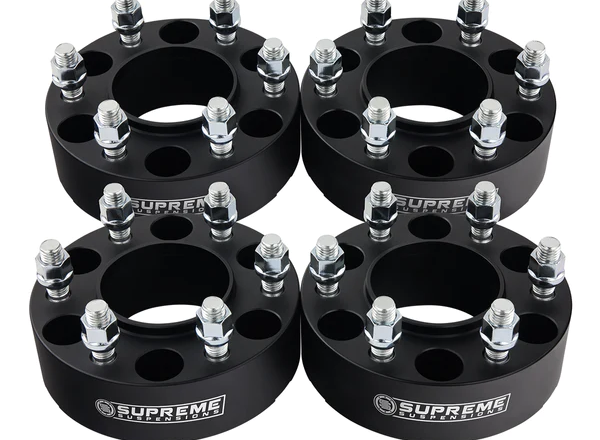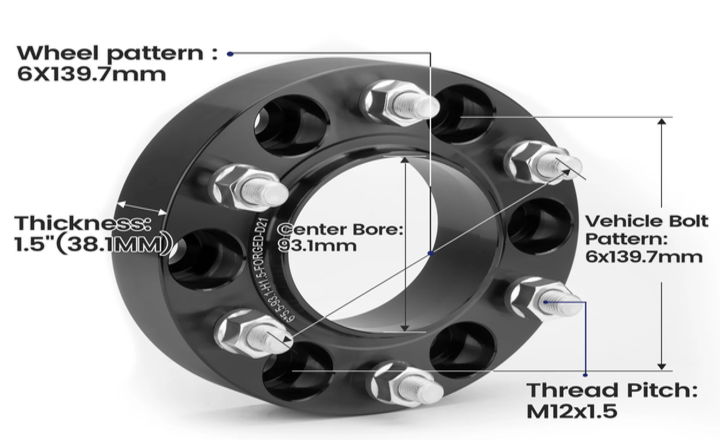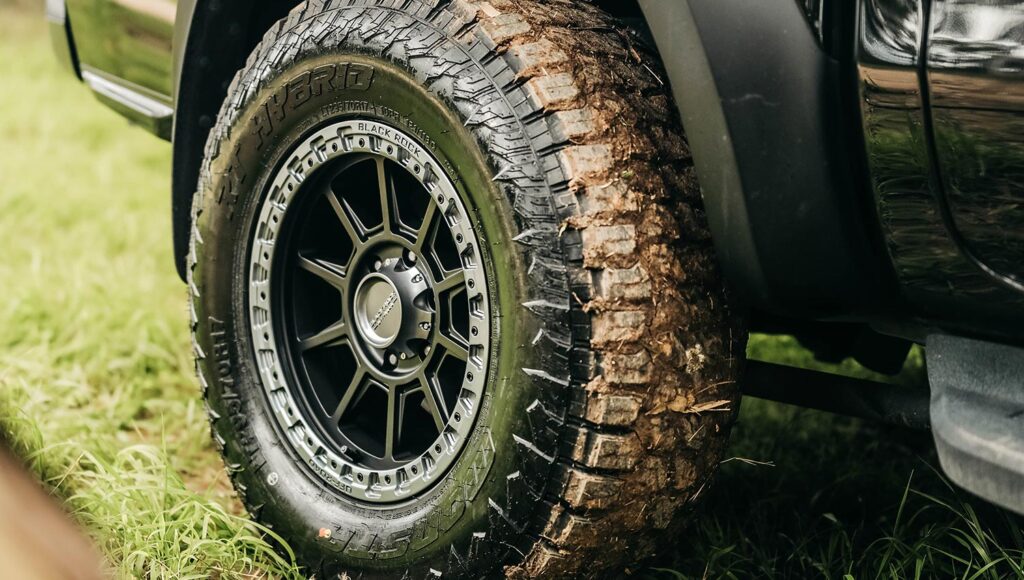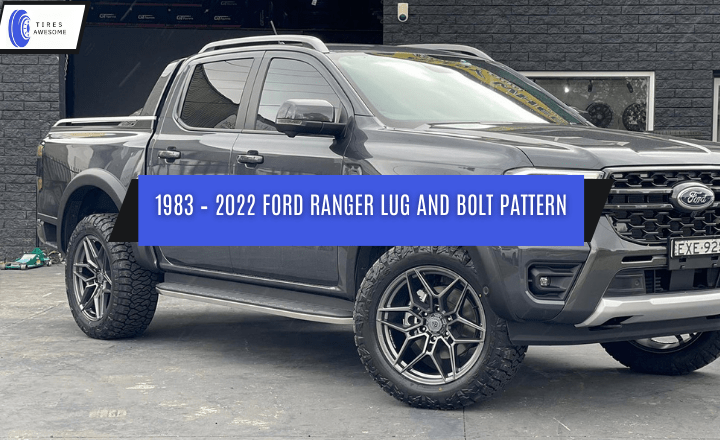Understanding the 1983–2022 Ford Ranger lug and bolt pattern is crucial to upgrading your wheels or replacing a damaged one. As a tire expert, I cannot stress enough the importance of Ford Ranger owners being well-versed in the evolved lug and bolt patterns.
This article covers the history and latest trends of the Ford Ranger. It will help you understand and improve your vehicle.
1983 – 1988 Ford Ranger Bolt And Lug Pattern
The first Generation of the Ford Ranger was produced from 1983 to 1988, with production continuing until the 1992 Ford Ranger bolt pattern for the Generation I facelift. This model featured a two-door regular cab configuration. The front suspension system utilized Twin-I-Beam independent suspension, enhancing stability and control on various leaf springs, contributing to a robust and durable design.

The Ford Ranger was designed to reduce the unsprung weight, improving performance and handling. Regarding the Ranger wheel bolt pattern models, they featured Ford Ranger bolt pattern 5 lug way on a circle with a diameter of 4.5 inches, or 114.3mm.
| Year/Make/Model | Lug Pattern | Bolt Pattern |
| 1983 Ford Ranger | 5 | 5×4.5″ (5×114.3mm) |
| 1984 Ford Ranger | 5 | 5×4.5″ (5×114.3mm) |
| 1985 Ford Ranger | 5 | 5×4.5″ (5×114.3mm) |
| 1986 Ford Ranger | 5 | 5×4.5″ (5×114.3mm) |
| 1987 Ford Ranger | 5 | 5×4.5″ (5×114.3mm) |
| 1988 Ford Ranger | 5 | 5×4.5″ (5×114.3mm) |
1989 – 1992 Ford Ranger Lug Pattern
In 1988, this Generation focused on enhancing the vehicle’s exterior aerodynamics and inner ergonomics, leading to significant modifications. Accompanied by these changes were a wide range of engine options, including inline-four, diesel, and V-6 engines.

The 1992-1989 Ford Ranger Bolt Pattern falls within a specific generation that featured a lug and bolt pattern of 5 4.5 (5×114.3mm)
| Year/Make/Model | Lug Pattern | Bolt Pattern |
| 1989 Ford Ranger Wheel Bolt Pattern | 5 | 5×4.5″ (5×114.3mm) |
| 1990 Ford Ranger Wheel Bolt Pattern | 5 | 5×4.5″ (5×114.3mm) |
| 1991 Ford Ranger Wheel Bolt Pattern | 5 | 5×4.5″ (5×114.3mm) |
| 1992 Ford Ranger Wheel Bolt Pattern | 5 | 5×4.5″ (5×114.3mm) |
1993 Ford Ranger Lug Pattern – 1997 Ford Ranger Bolt Pattern
The second-generation Ford Ranger, also known as the Mazda B-Series, was manufactured from August 1992 to July 1997. Although the chassis of the 1993 model closely resembled its predecessor, it featured a more streamlined and aerodynamic design. In 1994, the Ford Ranger was rebranded as the B-Series pickup truck.
The 1996 Ford Ranger lug pattern became the first compact pickup truck equipped with dual airbags in these model years. Drivers could choose between the efficient Ford Pinto LL23 I4 engine or more power with the Ford Cologne V6 or the Ford Vulcan V6 engines.
The second generation of the Ford RanGeneratione has the same lug and bolt pattern as its predecessor. This pattern remained consistent at 5×4.5″ (5×114.3mm), ensuring compatibility with wheels and tires.
| Year/Make/Model | Lug Pattern | Bolt Pattern |
| 1993 Ford Ranger Lug Pattern | 5 | 5×4.5″ (5×114.3mm) |
| 1994 Ford Ranger Lug Pattern | 5 | 5×4.5″ (5×114.3mm) |
| 1995 Ford Ranger Lug Pattern | 5 | 5×4.5″ (5×114.3mm) |
| 1996 Ford Ranger Bolt Pattern | 5 | 5×4.5″ (5×114.3mm) |
| 1997 Ford Ranger Lug Pattern | 5 | 5×4.5″ (5×114.3mm) |
1998 – 2000 Ford Ranger Lug And Bolt Pattern
The 1998-2000 Ford Ranger Bolt Pattern interior remained unaltered; its wheelbase and cab were extended to enhance passengers’ legroom. Ford upgraded the inline four-cylinder engine from 2.3 to 2.5 liters, improving the vehicle’s overall performance.
The lug and bolt pattern of the Ford Ranger generation was 5×4.5 inches (5×114.3mm).
| Year/Make/Model | Lug Pattern | Bolt Pattern |
| 1998 Ford Ranger Bolt Pattern | 5 | 5×4.5″ (5×114.3mm) |
| 1999 Ford Ranger Lug Pattern | 5 | 5×4.5″ (5×114.3mm) |
| 2000 Ford Ranger Lug Pattern | 5 | 5×4.5″ (5×114.3mm) |
2001-2003 Ford Ranger Lug Pattern
In 2001, the Ford Ranger Bolt Pattern introduced a significant upgrade, including a powerful 4-litre V6 engine, delivering an impressive boost of 207 horsepower. The towing capacity of the Ranger saw a substantial increase to an impressive 6,000 lbs.
During this period, the base engine was modified. It now featured a 2.3-liter Duratec inline four-cylinder engine. The third-generation facelift of the Ford Ranger was characterized by five lug holes and a measurement of 5×4.5″ (5×114.3mm).
| Year/Make/Model | Lug Pattern | Bolt Pattern |
| 2001 Ranger Lug Pattern | 5 | 5×4.5″ (5×114.3mm) |
| 2002 Ranger Lug Pattern | 5 | 5×4.5″ (5×114.3mm) |
| 2003 Ranger Lug Pattern | 5 | 5×4.5″ (5×114.3mm) |
2004-2005 Ford Ranger Bolt And Lug Pattern
A few notable changes were made in the Generation III Facelift 2 model. Along with a fresh new grille design, this Generation offered additional features such as a generator and optional leather upholstery, providing a more luxurious driving experience. The hood and front bumper of the vehicle were also modified, enhancing its overall appearance.

The Generation III Facelift 2 came equipped with a lug and bolt pattern of 5×114.3mm.
| Year/Make/Model | Lug Pattern | Bolt Pattern |
| 2004 Ford Ranger Lug Pattern | 5 | 5×4.5″ (5×114.3mm) |
| 2005 Ford Ranger Lug Pattern | 5 | 5×4.5″ (5×114.3mm) |
2006 – 2011 Ford Ranger Bolt And Lug Pattern
Starting in the 2007 model year, it included an anti-theft system, a personal safety system, a tire pressure monitoring system (TPMS), and an auxiliary audio jack for improved entertainment options.
In 2008, Ford introduced the LATCH system to the Ranger. This integrated feature helped ensure child safety by preventing passenger-side airbag deployment when a child was present. The Ford Ranger Generation III maintained previous years’ lug and bolt pattern, labeled explicitly as 5×4.5″ (5×114.3mm).
| Year/Make/Model | Lug Pattern | Bolt Pattern |
| 2006 Ford Ranger Bolt Pattern | 5 | 5×4.5″ (5×114.3mm) |
| 2007 Ford Ranger Lug Pattern | 5 | 5×4.5″ (5×114.3mm) |
| 2008 Ford Ranger Lug Pattern | 5 | 5×4.5″ (5×114.3mm) |
| 2009 Ford Ranger Lug Pattern | 5 | 5×4.5″ (5×114.3mm) |
| 2010 Ford Ranger Lug Pattern | 5 | 5×4.5″ (5×114.3mm) |
| 2011 Ford Ranger Lug Pattern | 5 | 5×4.5″ (5×114.3mm) |
2019 – 2022 Ford Ranger Bolt Lug Pattern
The Ford Ranger underwent a hiatus in North America from 2012 to 2018, resulting in a generational gap. It made a comeback in 2019 for the North American market as a compact pickup truck.
In size, it competes with other popular models such as the Toyota Tacoma, Chevy Colorado, and Chevy S10. The T6 fourth generation of the Ford Ranger offers two variants: the SuperCrew with a four-door crew-size cab and a five-foot bed, or the SuperCab model with 2+2 doors and an extended cab with a six-foot bed.
This versatile truck has an aluminum hood, a frame-mounted steel bumper, and a stylish grille. You’ll find a powerful 2.3-liter turbocharged EcoBoost four-cylinder gas engine.
The specific measurement for the lug and bolt pattern is 6×5.5″ (6×139.7mm). This means that the wheel of the Ford Ranger has six lug holes, and its pitch circle diameter, also known as PCD, measures 5.5 inches or 139.7 mm.
| Year/Make/Model | Lug Pattern | Bolt Pattern |
| 2019 Ranger Lug Pattern | 6 | 6×5.5″ (6×139.7mm) |
| 2020 Ford Ranger Lug Pattern | 6 | 6×5.5″ (6×139.7mm) |
| 2021 Ranger Lug Pattern | 6 | 6×5.5″ (6×139.7mm) |
| 2022 Ranger Lug Pattern | 6 | 6×5.5″ (6×139.7mm) |
Conclusion
There are also some best years for the Ford Ranger But the Ford Ranger lug and bolt pattern has remained consistent from 1983 to 2022. This pattern, commonly known as 5×114.3 or 5×4.5, refers to the number of lug nuts on the wheel hub and the diameter of the circle they form.
Owners can easily find compatible vehicle wheels and tires without making any changes. Whether you have an old Ford Ranger or a new one, you can be sure that finding the right aftermarket wheels won’t be difficult. So, check out your options to improve your vehicle’s performance and looks!
FAQs
Where Is The Ford Ranger Made?
The 2023 Ranger will be made in Detroit, as well as in Thailand and South Africa. The US might call it a 2024 model. The Australian vehicles are made in Thailand, and the Volkswagen Amarok version is made in South Africa.
What Is The Standard Lug Size?
The standard lug sizes are 17 mm, 19 mm, and 21 mm, while less commonly used measures include 22 mm, 23 mm, 17.5 mm (11/16 inch), and 20.6 mm (13/16 inch).
Are Old Ford Rangers Reliable?
The Ford Ranger has excellent reliability ratings from JD Power, Consumer Reports, and RepairPal. It is ranked 3rd in its class for reliability with a 4.0 out of 5 rating. This makes the used Ford Ranger a dependable truck option available near you.
What Is A Common 4 Lug Pattern?
A 4 lug pattern is how wheel studs are arranged on a car’s hub to attach a wheel. The most common 4 lug pattern is 4×100, with four wheel studs spaced 100mm apart in a circle. This pattern is often on small cars like compact and subcompact models.
What PCD Is 4×100?
The PCD (Pitch Circle Diameter) of 4×100 tells us the wheel’s bolt pattern. The 4 means there are four bolts on the wheel hub, and the 100 is the distance in millimeters between the centers of any two adjacent bolts. So, a wheel with a PCD of 4×100 has four bolts evenly placed around a circle with a 100mm diameter.
How Is PCD Calculated?
To find the PCD, measure the distance between two opposite bolt holes on the circle. Divide this distance by the square root of 2 (about 1.414) to get the PCD value. The formula for PCD is: PCD = D x sin(180 N), where D is the distance between two adjacent bolt holes and N is the number of bolt holes on the object.

